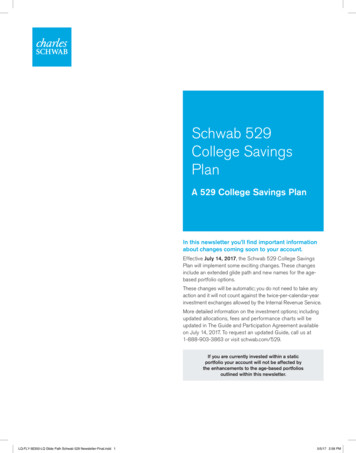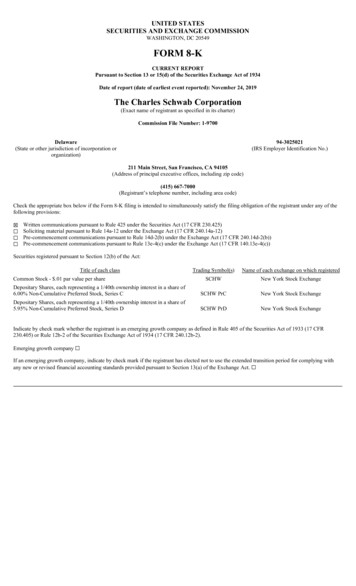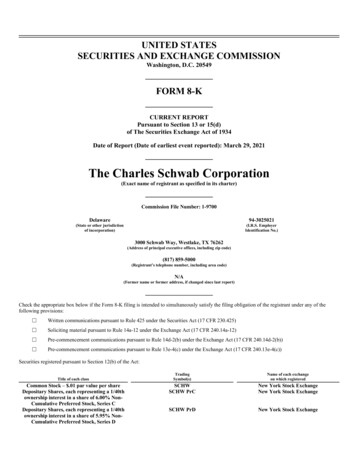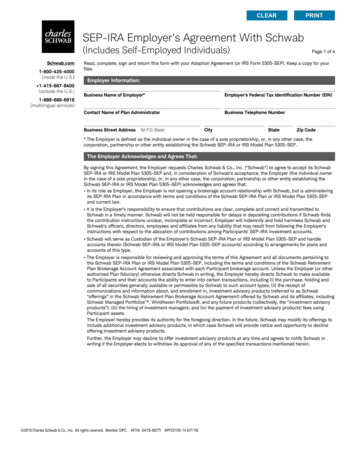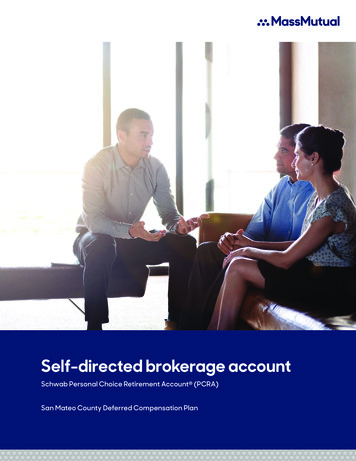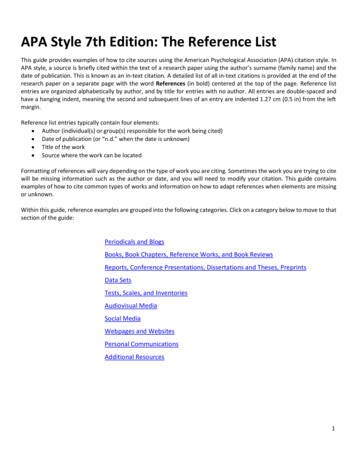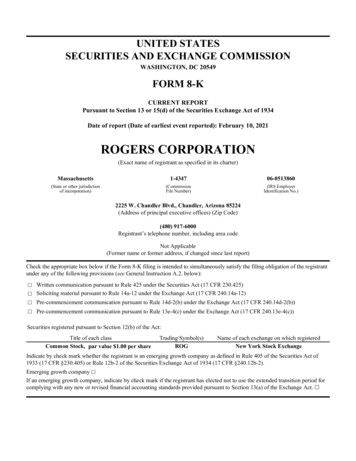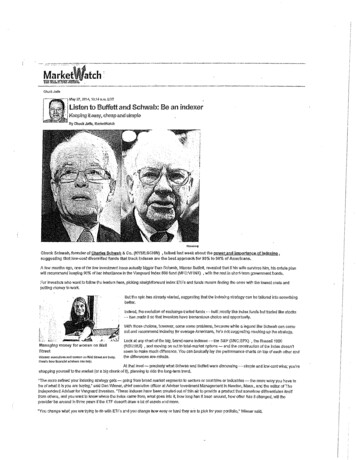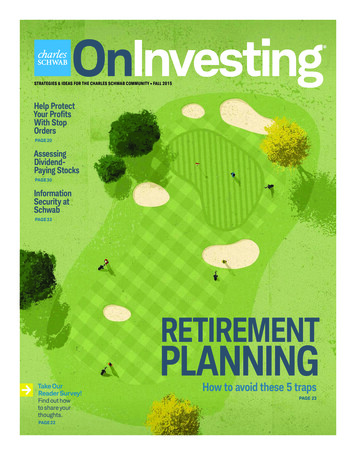
Transcription
OnInvestingSTRATEGIES & IDEAS FOR THE CHARLES SCHWAB COMMUNITY FALL 2015Help ProtectYour ProfitsWith StopOrdersPAGE 20AssessingDividendPaying StocksPAGE 30InformationSecurity atSchwabPAGE 33RETIREMENTPLANNINGHow to avoid these 5 trapsTake OurReader Survey!PAGE 23Find out howto share yourthoughts.PAGE 22dOI Fa15 00 Cover.indd 1OI-Fa15-Q3-C17/14/15 3:19 PM
Nothing is moresatisfying to us thansatisfied clients.Schwab ranked “Highestin Investor Satisfaction withSelf-Directed Services.”We love hearing from our clients, so stopby your local Schwab branch or give us acall at 1-800-4SCHWAB.J.D. Power’s 2015 Self-Directed Investor Satisfaction Rankings: Charles Schwab & Co., Inc. received the highest numerical score among self-directed investingservice providers in the proprietary J.D. Power 2015 Self-Directed Investor Satisfaction Study.SM Study based on responses from 3,776 investors measuring10 providers, and measures satisfaction of self-directed investors. Proprietary study results are based on experiences and perceptions of consumers surveyedin January-February 2015. Your experiences may vary. Visit jdpower.com. 2015 Charles Schwab & Co., Inc. All rights reserved. Member SIPC. (0715-4448) ADP87114-00dOI Fa15 C2-C4.indd 2OI-Fa15-Q3-C27/14/15 3:48 PMADP8301.13.2
CONTENTSD E PA R T M E N T S42 From the WebExplore On Investing andmore online.3 CEO’s NoteWhy investors shouldn’t be toocomplacent about inflation.By Walt Bettinger4 The Bottom LineLow-volatility ETFs, negativeinterest rates and more.10 Ask CarrieUnderstand the finances ofmoving to a smaller home.By Carrie Schwab-Pomerantz132313 PerspectivesWashingtonHow the markets may react tothe latest partisan gridlock.By Michael Townsend16BondsPrepare your bond portfoliofor rising rates.By Kathy Jones18InternationalEmerging markets could offergrowth and diversification.By Jeffrey Kleintop20 TradingHow to use stop orders to helpprotect profits.By Randy Frederick38 SpotlightResearchWhere to find our experts’ mutualfund and ETF selections online.40 ProductsSchwab Bank’s debit card canhelp you travel with confidence.44 On Your SideCover Illustration: Mark SmithWaiting for the “right” time toinvest can be costly.By Charles R. Schwab2630F E AT U R E S23 5 RETIREMENTPLANNING MYTHSDon’t let optimistic expectations putyour retirement at risk.26 REAL ASSETSCommodities’ recent strugglesshouldn’t overshadow theirlong-term appeal.30 GETTING TO KNOWDIVIDEND STOCKSDividend-paying stocks may offervalue even if rates rise.33 INFORMATIONSECURITYSchwab is always working to keepyour personal information—and yourmoney—safe.On Investing (ISSN 1523-5327) is published quarterly. This publication is mailed at Standard A postal rates.If you prefer not to receive On Investing, please call 888-484-5340.POSTMASTER: Send address changes to On Investing, Charles Schwab & Co., Inc., P.O. Box 52114, Phoenix, AZ 85072–2114. On Investing does not assume any liabilityresulting from actions taken based on the information included in this magazine. Mention of a company or security does not constitute endorsement. Some contributors toOn Investing may have active positions in securities or companies discussed in this issue. NWS73442Q315F A L L 2 0 15 O N I N V E S T I N GdOI Fa15 01 TOC.indd 1OI-Fa15-Q3-117/16/15 1:44 PM
FROMTHE WEB:SCHWAB.COMOn Investing onlineOn Investing is now available as part of Insights& Ideas on schwab.com. You can find the samesmart, helpful insights you’re used to—whetheryou’re on a desktop computer, a tablet or amobile phone.IthonseininBOARD OF ADVISORSJonathan CraigExecutive Vice PresidentChief Marketing OfficerHERE’S A SAMPLE OF SOME RECENTARTICLES ON INSIGHTS & IDEAS:CONNECTWITH SCHWABWOnInvesting- Explore the magazine and more atschwab.com/OIinsights.- Sign up to receive email alerts when anew issue of On Investing is available atschwab.com/OIpaperless. IIS A PHASED RETIREMENTRIGHT FOR YOU?focaanuswriMark W. Riepe, CFASenior Vice PresidentSchwab Center for Financial ResearchHelen LohPORTFOLIOREPAIR:A CASE FORREBALANCINGSenior Vice PresidentContent & Client Marketingrebetr20thLarry HanbackVice PresidentMarketing Strategy & OperationsINVESTING@charlesschwabEDITOR IN CHIEFINTERNATIONALTamar Dorsey@jeffreykleintopMARKETS AND ECONOMYINVESTING BASICS: HOWCHASING RETURNS CANSABOTAGE YOUR SAVINGS@lizannsondersFIXED INCOME@kathyjonesanbealitin19rehayobudoinMANAGING EDITORStephanie MayASSOCIATE MANAGING EDITORJeremy omfacebook.com/charlesschwab2 Getty Imagesschwab.com/emailusC H A R L E S S C H WA B F A L L 2 0 15dOI Fa15 02-03 Web CEO.indd 2OI-Fa15-Q3-27/21/15 1:49 PM Schwab Photo LibraryWalt BettingerRandy FrederickKathy JonesJeffrey KleintopCharles R. SchwabCarrie Schwab-PomerantzMichael Townsend888-484-53401BTreacprth 2(09
ceo’s noteInflation and the Long ViewWhy investors shouldn’t be too complacent about rising prices.Inflation has been so low for solong that investors could easilyhave become complacent aboutthe impact of this value-eroding forceon their portfolios. That would be aserious mistake. Even relatively mildinflation has a significant effect on yourinvestments over time.Some inflation can be a good thingfor the economy. A steady rise in pricescan encourage spending by consumersand businesses. And working peopleusually don’t mind a bit of inflation, aswage increases tend to keep pace withrising consumer prices.It’s a different story for savers andretirees. After all, money loses valuebecause of inflation—prices nearlytripled between 1980 and the end of20141—and rising prices eat away atthe real returns on your investments.Ever since the financial crisis, theannual rate of inflation has generallybeen below 2%. But if you go backa few decades, things start to look alittle different. The average annualinflation rate was about 3.5% between1980 and 2014. Your investmentreturns over that period would havehad to match that rate just to keepyour portfolio treading water. Tobuild wealth, of course, you need todo better. And the recent era of lowinterest rates hasn’t helped.g Schwab Photo Library Getty ImageschThe good news is that there areseveral precautions you can take tohelp insulate your portfolio againstinflation. Stocks have historicallydelivered solid inflation-adjustedreturns. You could also consideradding Treasury Inflation ProtectedSecurities (TIPS) to your bondportfolio. The coupon rate on TIPSis fixed, but the principal value isadjusted to keep pace with inflation—so interest payments fluctuatealong with inflation. Real estate andcommodities can also help protect aportfolio against rising prices.So check in with a Schwabrepresentative to find out what stepsyou could take to add inflationhedging features to your portfolio.Inflation may not seem like a majorproblem now, but experiencedinvestors know that they can’t ignoreit—even moderate annual changes canhave a big impact over time.Sincerely,“The good newsis that there areseveral precautionsyou can take tohelp insulate yourportfolio againstinflation.”Walt BettingerPresident & CEO1Bureau of Labor Statistics data as of 4/23/2015.Treasury Inflation Protected Securities (TIPS) are inflation-linked securities issued by the U.S. government whose principal value is adjusted periodically inaccordance with the rise and fall in the inflation rate. Thus, the interest amount payable is also impacted by variations in the inflation rate as it is based upon theprincipal value of the bond. It may fluctuate up or down. Repayment at maturity is guaranteed by the U.S government and may be adjusted for inflation to becomethe greater of either the original face amount at issuance or that face amount plus an adjustment for inflation. 2015 Charles Schwab & Co., Inc. All rights reserved. Member SIPC.(0915-3780)F A L L 2 0 15 o n i n v e s t i n gdOI Fa15 02-03 Web CEO.indd 3OI-Fa15-Q3-338/24/15 10:47 AM
The bottom lineIn Search of a Smoother RideETtLow-volatility ETFs try to mitigate big market swings.SDo theResearchLog in toschwab.com/OIETFselectlist tofind low-volatilityETFs under“domestic equity”and “internationalequity” on the ETFSelect List ngstar Direct as of 4/20/2015.Ibid.12See page 42 for important information.Investors should consider carefully information containedin the prospectus, including investment objectives, risks,charges and expenses. You can request a prospectusby calling Schwab at 800-435-4000. Please read theprospectus carefully before investing.Charles Schwab Investment Advisory, Inc. (“CSIA”) is an affiliate ofCharles Schwab & Co., Inc. (“Schwab”).(0915-3248) Rob WilsonStock market volatility has been part of theinvesting landscape in 2015. This volatilityhas pushed some investors into low-volatilityexchange-traded funds (ETFs), which seek tominimize the effect of large market swings. Theassets in such ETFs jumped by about 26% in the firstfour and a half months of the year.1 Low-volatilityETFs have been around for less than five years, buthave already attracted 18.4 billion in assets.2Low-volatility ETFs generally work in one oftwo ways. One type screens and weights the stocksincluded in an index—such as the S&P 500 Index—according to their volatility. The least volatile stocksare given larger weightings. This usually meansincluding more utility and consumer staples stocks,which tend to experience smaller price movementsthan stocks in other sectors.The other type of low-volatility ETF includes abroader universe of stocks and weights them basedon how correlated, or linked, their price movementsare with each other. While such ETFs don’t explicitlyavoid volatility per se, their weighting methodologyItends to result in holdings thatnegate each other’s price swings.This can result in less-volatileperformance, whether the market isrising or falling.Whether low-volatility ETFsmake sense for you depends on yourexpectations for the market andyour returns, says Michael Iachini,Managing Director of ETF andMutual Fund Research at CharlesSchwab Investment Advisory, Inc.“Low-volatility ETFs may be rightfor investors who aren’t necessarilypessimistic about the marketbut who would prefer to avoidlarge swings in the value of theirportfolio,” he says.One thing to consider with theseETFs is that limiting losses likelylimits gains as well. In other words,when you invest in low-volatilityETFs you could be giving up somepotential upside when markets are rising. “In a longrunning bull market, lower volatility funds typicallyhave a hard time keeping up,” Michael says.Depending on the market segment, low-volatilityETFs may also have higher operating expenses thanstandard index funds, Michael says. That is becauseminimizing volatility generally requires morefrequent rebalancing. For example, ETFs weightingU.S. large-capitalization companies by volatility tendto have higher expenses than other U.S. large-capstock ETFs. -C h a r l e s s c h wa b F A L L 2 0 15dOI Fa15 4-5 8-9 BottomLine.indd 4OI-Fa15-Q3-47/14/15 3:23 PMeffthovsem
ETF Expensesto WatchSmall differences in fees can add up.It’s easy to see why exchange-traded funds (ETFs) are popular.They can offer exceptional liquidity and are a relativelyinexpensive way to gain exposure to a variety of asset classes.But some ETFs are cheaper than others. Here are threeexpenses to watch.Commissions. Because ETFs trade on an exchange, you mayhave to pay a commission when you buy or sell one. Thoughsome ETFs are available commission-free, many are not.Operating expenses. These costs are generally levied at anannual rate known as an operating expense ratio (OER). Suchfees cover the day-to-day costs of managing the ETF’s assets,administration and other costs. Investors don’t pay these feesdirectly. Rather, fund managers deduct the operating expensesdaily from an ETF’s total average assets.OERs are listed in an ETF’s prospectus. They can vary widely:from as little as a few basis points to as much as a few percentagepoints, with some ETFs charging up to 3.87%.1Even small differences in fees can have a big impact on yourportfolio over time. For example, imagine you invested 100,000in an ETF with an OER of 0.1%. Assuming an annual return of6% and no other fees, after 20 years your investment would haverisen to 314,360.2 Now imagine you invested the same amountsur-Less Than ZeroNegative European bondyields are intensifying theglobal search for yield.Wd Rob Wilsoneds,hy would anyone buy a bondwith a negative rate of return?It’s a question investorsin some European country bonds aregrappling with after yields dipped belowzero in recent months. That meansinvestors are paying countries for theprivilege of lending them money.Unfortunately for U.S. investors, theeffects of negative yields aren’t restrictedto the market for euro bonds. Negativeyields overseas may be drawing moreincome-seeking global investors to theU.S. bond market, where yields are stillin an ETF with an annual OER of 0.5%.After 20 years, you’d have just 290,121.The bid/ask spread. The differenceDo the Researchbetween the price at which an ETFTo compare ETFcan be sold (“bid”) and the price atcosts, log in towhich an ETF can be bought (“ask”)schwab.com/is an often-overlooked cost. It is builtOIETFscreenerinto the market price and is paid onand select “basiceach roundtrip purchase and sale of ancriteria.”ETF. The larger the spread and the morefrequently you trade, the more relevant this cost becomes.Factors driving bid/ask spreads can include market liquidityand inventory-management costs recouped by the marketmakers who facilitate ETF trades. Bid/ask spreads tend to belower for more actively traded and more liquid ETFs. 1Charles Schwab analysis of ETF annual report data in Morningstar Direct as of4/16/2015.2Based on calculations using the Financial Industry Regulatory Authority’s FundAnalyzer. Results are hypothetical.See page 42 for important information.Investors should consider carefully information contained in theprospectus, including investment objectives, risks, charges andexpenses. You can request a prospectus by calling Schwab at800-435-4000. Please read the prospectus carefully before investing.Investment returns will fluctuate and are subject to market volatility, so that aninvestor’s shares, when redeemed or sold, may be worth more or less than theiroriginal cost. Unlike mutual funds, shares of ETFs are not individually redeemabledirectly with the ETF. Shares are bought and sold at market price, which may behigher or lower than the net asset value.(0915-3311)above zero. That extra demand may besuppressing Treasury yields.Once a rare occurrence, negativeyields on bonds have now become quitecommon. More than 1.9 trillion of theeuro region’s government securities had anegative yield at the end of February.1What’s causing it? To help fight offdeflation and spur economic growth,central banks in Europe have adoptednegative interest rates in the hope bankswill start lending more to consumers andbusinesses. Meanwhile, the EuropeanCentral Bank cranked up a sovereignbond-buying program to further stimulatethe economy. As a result, yields on bondstumbled from already low levels.Most of the demand for such bondscomes from institutions that are requiredto allocate a portion of their holdings tostate-issued securities.Kathy Jones, Senior Vice Presidentand Chief Fixed Income Strategist at theSchwab Center for Financial Research,says most individual investors would bebetter off staying away.She notes that Treasuries remain abetter choice—yields are low, but theystill have a way to go before they fallbelow zero—and cash might be the nextbest option. Call UsFor help with your bondinvestments, call 866-893-6699to speak with a Schwab FixedIncome Specialist.1David Goodman and Lukanyo Mnyanda, “Euro-AreaNegative-Yield Bond Universe Expands to 1.9 Trillion,”Bloomberg, 2/28/2015.See page 42 for important information.(0915-3358)F A L L 2 0 15 o n i n v e s t i n gdOI Fa15 4-5 8-9 BottomLine.indd 5OI-Fa15-Q3-557/16/15 1:52 PM
What’s inyour index?Does your portfolio reflect the latest thinking on index construction?STEP1Start withthe same groupof stocksBoth indexes use the Russell 3000 Index asthe starting point.RussellFundamentalU.S. LargeCompany IndexSelects and weightsstocks basedon the financialcharacteristics of theunderlying companiesin the Russell 3000Russell1000 IndexRepresents thehighest-ranking1,000 stocks inthe Russell 3000Index in terms ofmarket capSTEP2Analyze stocksEach index uses a different methodology toidentify which stocks to include.Russell Fundamental Adjustedsales Retainedoperatingcash flow3Investors should consider carefully information contained in theprospectus, including investment objectives, risks, charges andexpenses. You can request a prospectus by calling 800-435-4000.Please read the prospectus carefully before investing.Investment returns will fluctuate and are subject to market volatility, so that aninvestor’s shares, when redeemed or sold, may be worth more or less than their6 Stock’scompositefundamentalscoreRussell 1000OutstandingsharesSource: Schwab Center for Financial Research. Index data from Russell Indexes andResearch Affiliates as of 3/31/2015. Constituents are subject to change withoutnotice. For illustrative purposes only; this is not a recommendation to buy or sellany particular security.Dividendsplusbuybacks Marketprice Marketcaporiginal cost. Unlike mutual funds, ETF shares are bought and sold at marketprice, which may be higher or lower than the net asset value.Index ownership—“Russell Fundamental U.S. Large Company Index” is a jointtrademark of Frank Russell Company (“Russell”) and Research AffiliatesLLC (“RA”) and is used by the fund under license. “Research Affiliates” and“Fundamental Index” are trademarks of RA. Subject to RA’s intellectual propertyrights in certain content, Russell is the owner of all copyrights related to theRussell Fundamental Index Series. Russell is the owner of the trademarks andcopyrights related to the Russell Indexes.The Russell 1000 Index measures the performance of the large-cap segmentof the U.S. equity universe. It is a subset of the Russell 3000 Index andinccoThinthinIndex 2(08C H A R L E S S C H WA B F A L L 2 0 15dOI Fa15 6-7 Infographic.indd 6OI-Fa15-Q3-6Stfuasba7/15/15 5:13 PM
?toAt Schwab, we believe a well-diversified portfolio combines more than oneapproach to indexing.Traditionally, indexes have been constructed using market-capitalizationstrategies, which analyze stocks according to their market size. By combining marketcap indexes with indexes that are constructed based on the stocks’ fundamentalcriteria, investors may achieve greater portfolio diversification.So what makes the two indexing styles different? Just like two competing teams,each index has its own set of attributes—in this case, the system it uses to screen andweight individual stocks—that distinguishes it from the competition.Let’s look at how two indexes, the Russell Fundamental U.S. Large Company Indexand the Russell 1000 Index, are created.STEP3Determine ranksThe higher the rank, the bigger theimpact on the index’s performance.Russell Fundamental rankStocks are ranked byfundamental score andassigned percentage weightsbased on those scores.Russell 1000 rankStocks are ranked by marketcap. Weights in the indexare calculated by dividing astock’s market cap by theindex’s total market cap.Top 10 holdingsExxon MobilChevronAT&TMicrosoftWal-Mart StoresProcter & GamblePfizerAppleIBMJPMorgan 1.32%123456789101 3.55%2 1.73%3 1.59%4 1.35%5 1.25%6 1.23%7 1.18%8 1.08%9 1.05%10 1.05%AppleExxon MobilMicrosoftJohnson & JohnsonBerkshire HathawayWells FargoGeneral ElectricJPMorgan ChasePfizerProcter & Gambleincludes approximately 1,000 of the largest securities based on acombination of their market cap and current index membership.The Russell Fundamental U.S. Large Company Index ranks companiesin the Russell 3000 Index by fundamental measures of size and tracksthe performance of those companies whose fundamental scores arein the top 87.5% of the Russell 3000 Index.Indexes are unmanaged, do not incur management fees, costs orexpenses, and cannot be invested in directly. 2015 Charles Schwab & Co., Inc. Member SIPC. All rights reserved.(0815-4479)Why indexingmethodologiesmatterBoth indexes include many of thesame stocks, but the weights ofthose stocks often vary widely. Asa result, these two indexes tend toperform differently during differentmarket cycles.Having exposureto both types ofindexes can providediversification benefits.NEXT STEPSResearch ETFs and index funds basedon fundamental strategies entalfundsF A L L 2 0 15 O N I N V E S T I N GdOI Fa15 6-7 Infographic.indd 7OI-Fa15-Q3-777/15/15 5:13 PM
The bottom lineTLearn MoreRead our biweeklyinternationalcommentary atschwab.com/OIcommentary.8he U.S. dollar had a strong start in 2015.During the first quarter, the dollar hit a12-year high against the euro,1 and aneight-year high against the Japanese yen.2These gains—resulting largely from therelative strength of the U.S. economy comparedto overseas economies—create a challenge forpeople with international investments. Stockand bond investments denominated in euros oryen look a lot less valuable when you convertthem into U.S. dollars.This isn’t to suggest that investors shouldthink twice about investing abroad. Foreignassets offer the potential for diversification andother benefits that shouldn’t be ignored. Butthe situation has left some investors wonderingwhether they should try to hedge theirportfolios against potential currency necbesltow1James Ramage, “U.S. Dollar Pushes to New 12-Year HighAgainst the Euro,” The Wall Street Journal, 3/13/2015.2“Dollar Rises to 8-Year High Against the Yen,” Reuters,3/10/2015.See page 42 for important information.Investors should consider carefully informationcontained in the prospectus, including investmentobjectives, risks, charges and expenses. You can requesta prospectus by calling Schwab at 800-435-4000.Please read the prospectus carefully before investing.Past performance is no guarantee of future results.(0915-3221)C h a r l e s s c h wa b F A L L 2 0 15dOI Fa15 4-5 8-9 BottomLine.indd 8OI-Fa15-Q3-87/14/15 3:23 PM Rob WilsonA soaring dollar raises hedging questions.Ste Rob WilsonTime to Hedge?DMWhen you hedge, you try to minimize theeffect of currency fluctuations on your portfolioby investing in assets that move in the oppositedirection of your target currency. For example, ifyou think the euro is going to fall against the dollar,you might seek out investments that will rise as theeuro weakens, negating the effect of the change.There are several ways to hedge. You couldshort foreign currency futures, but doing so canbe complex and expensive. For this reason, manyinvestors opt for investments that do the workfor them, such as exchange-traded funds (ETFs)or mutual funds that hedge currency exposure.Some ETFs and mutual funds state their hedgingpolicy in their prospectus or annual reports. (If thisinformation isn’t available, you could call the fundcompany and ask, though proprietary informationmay not be shared.)Before deciding whether to hedge, you shouldremember that while currency hedging maysmooth the performance of a portfolio whencurrency markets are volatile, it also removessome of the diversification benefit that comesfrom investing overseas. The dollar isn’t likely tobe strong forever, and if it weakens, the returns onoverseas assets will get a boost.In general, Schwab doesn’t usually suggesthedging currency exposure in equities becauseit can be costly. However, given the low yields oninternational fixed income investments, there maybe a case for hedging this part of your portfolio,says Kathy Jones, Senior Vice President and ChiefFixed Income Strategist at the Schwab Center forFinancial Research.“The yields on many fixed income investmentsgenerally are going to be small—maybe less thanor equal to what investors will get in the UnitedStates—so investors might want to ensure thatcurrency swings don’t erode those thin returns,”she says. -fincocrinin
Does SmallerMean Better?ar,heSmall-cap stocks’ fortunestend to rise with the dollar.S)hisdononnmayefortsand,” Rob Wilson Rob Wilsonsttocks with small market capitalizations—generally, those with a market value ofless than 1 billion—had a much betterstart to 2015 than their large-cap counterparts.The Russell 2000 Index, a proxy for small-capstocks, returned 4.4% during the first quarter,while the large-cap Dow Jones IndustrialAverageTM fell 0.3%. By mid-May, the Dow hadnarrowed the gap, returning 3.63% comparedwith the Russell Index’s 4.84%, but thedifference was still noteworthy.Much of the disparity has to do withsmall-caps’ heavier reliance on the domesticeconomy. Improving economic conditionshave been a boon for smaller companies interms of demand. Growing sales, combinedwith favorable borrowing conditions, havemade it easier for small companies to securethe financing they need to expand.Then there’s the strong U.S. dollar. A risingdollar hurts the earnings of companies thatdo a lot of business in overseas markets withweaker currencies. This generally affects largecompanies more than small ones.However, the factors that have recentlybuoyed small-cap stocks also tend tomake such stocks more volatile, says BradSorensen, Director of Market and SectorAnalysis at the Schwab Center for FinancialResearch. For example, their relative lackof overseas exposure may give small-capsan advantage over large-caps when the U.S.economy is growing, but that advantagebecomes a liability when domestic growthslows. Small companies may not be ableto rely on overseas sales to make up forweakness at home.And because they generally lack thefinancial resources of large companies, smallcompanies are more sensitive to tighteningcredit conditions, which could be a problemin a rising interest rate environment.Still, it makes sense for most investors toinclude small-caps in their stock portfolio,Brad says. After all, because small-caps tendto perform differently than large-cap stocks,they could provide diversification benefits.But investors should proceed cautiously.“Spread your small-cap investmentsamong multiple stocks because investing inindividual small-cap stocks is just addinganother layer of risk,” Brad says.Exchange-traded funds (ETFs) and mutualfunds that focus on small-cap stocks are astraightforward way to diversify your exposureto this group at a relatively low cost. -Do theResearchSee our experts’top picks forsmall-cap ETFsby logging in toschwab.com/OIETFselectlist.See page 42 for important information.Investors should consider carefully information contained in the prospectus,including investment objectives, risks, charges and expenses. You canrequest a prospectus by calling Schwab at 800-435-4000. Please read theprospectus carefully before investing.Investment returns will fluctuate and are subject to market volatility, so that an investor’sshares, when redeemed or sold, may be worth more or less than their original cost. Unlikemutual funds, shares of ETFs are not individually redeemable directly with the ETF. Sharesare bought and sold at market price, which may be higher or lower than the net assetvalue (NAV).Past performance is no guarantee of future results.(0915-3200)F A L L 2 0 15 o n i n v e s t i n gdOI Fa15 4-5 8-9 BottomLine.indd 9OI-Fa15-Q3-997/21/15 4:49 PM
Ask CarrieThinking AboutDownsizing?Understand the finances ofmoving to a smaller home.By Carrie Schwab-Pomerantz—A ReaderDear Reader,Pardon the pun, but thistopic hits very close tohome for me. As I preparethis column, my husband andI are packing up the past 14years of our lives to move to asmaller home. Our youngest isoff to college, and like so manyothers at this stage of life, wemade the tough decision toleave our rambling (and highmaintenance) family abode.Personal issues aside, there’sno question that downsizingcan have many financialadvantages. Having a smallerhouse can mean less upkeepand lower monthly expenses—10First, the basicsIn order to claim the maximumexclusion, you have to pass whatthe IRS calls the ownership anduse tests. This means:1. You must have owned thehouse for two years.2. And you must have lived inthe house as your principalresidence for two out of thelast five years, ending onthe date of the sale.There are a few exceptionsto these rules. For example, ifyou had to move before owningthe home for two years becauseof a job change, or becauseyou experienced what the IRSdesignates an “unforeseencircumstance,” such as a divorceor natural disaster, then the IRSwill allow you to prorate theexclusion. (If you go througha divorce after having lived inthe home for just one year, youwould be entitled to 50% ofthe exclusion.)And the two years of residencydon’t have to be consecutive—you just have to have lived in yourhoofInexloprtwCcC h ar l e s sc h wab F A L L 2 0 15dOI Fa15 10-12 Carrie.indd 10OI-Fa15-Q3-107/16/15 1:59 PM Getty ImagesI’m thinking about downsizingmy home when I retire. WillI get hit with a tax bill when Isell my house?to say nothing of potentialcash from the sale. And as youmention, taxes can be a big partof the decision.There has been a fair amountof confusion over this topicever since the rules changeddramatically back in 1997.Many of us Baby Boomersremember the old days whenyou could trade up to a moreexpensive home within twoyears to postpone taxes, or takeadvantage of the once-in-alifetime exclusion for those whowere 55 or older.But it’s a new day. Undercurrent law, if you sell yourprincipal residence for a profit,up to 250,000 of that capital gainis excluded from tax.1 Marriedcouples filing a joint return canexclude up to 500,000.This means that many peoplewon’t have to pay capital gains taxat all. Others, though, especiallythose who have ow
Commodities’ recent struggles shouldn’t overshadow their long-term appeal. 30 GETTING TO KNOW DIVIDEND STOCKS Dividend-paying stocks may offer value even if rates rise. 33NORF I MONATI SECURITY Schwab is always working to keep your personal information—and your money—safe. On In

